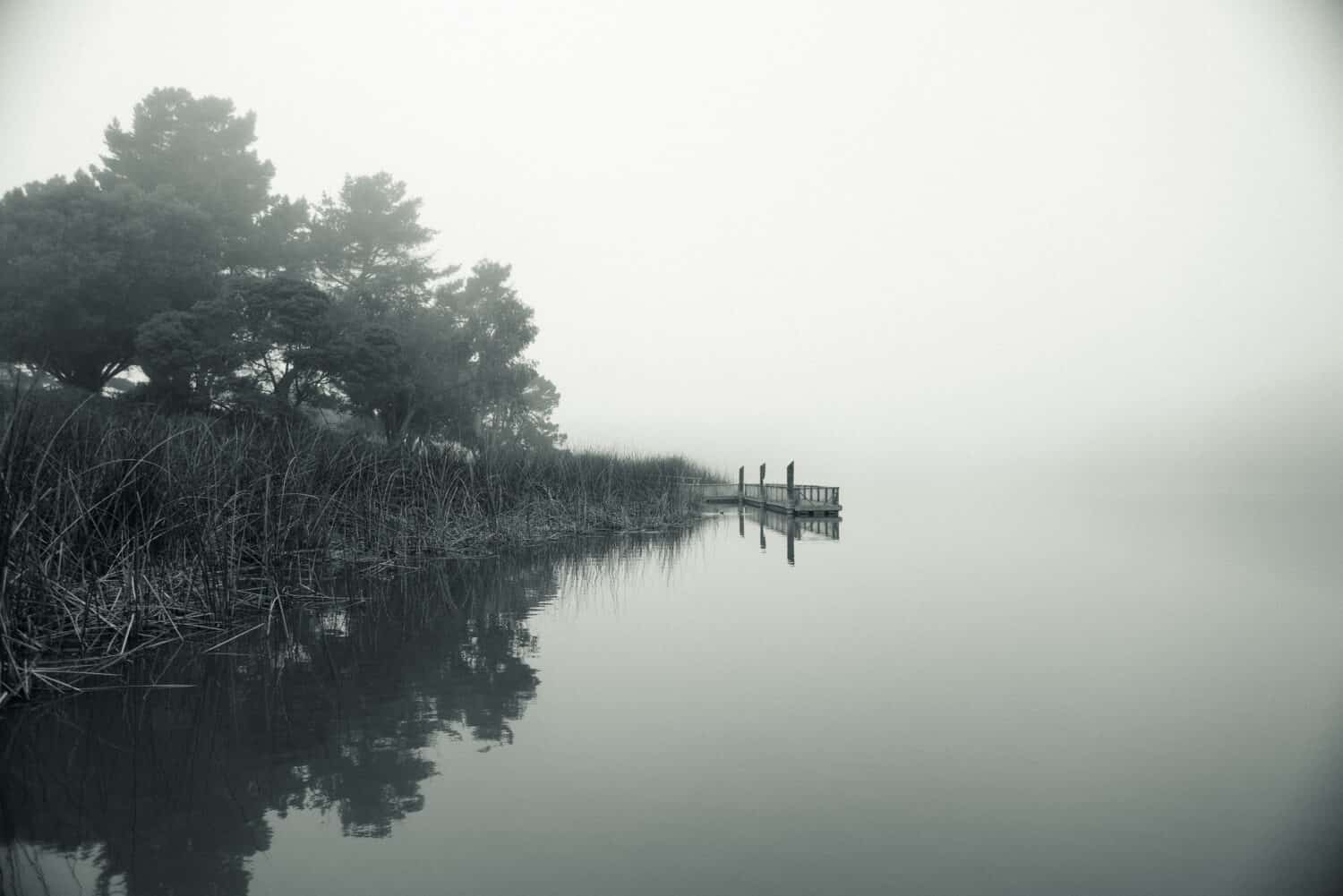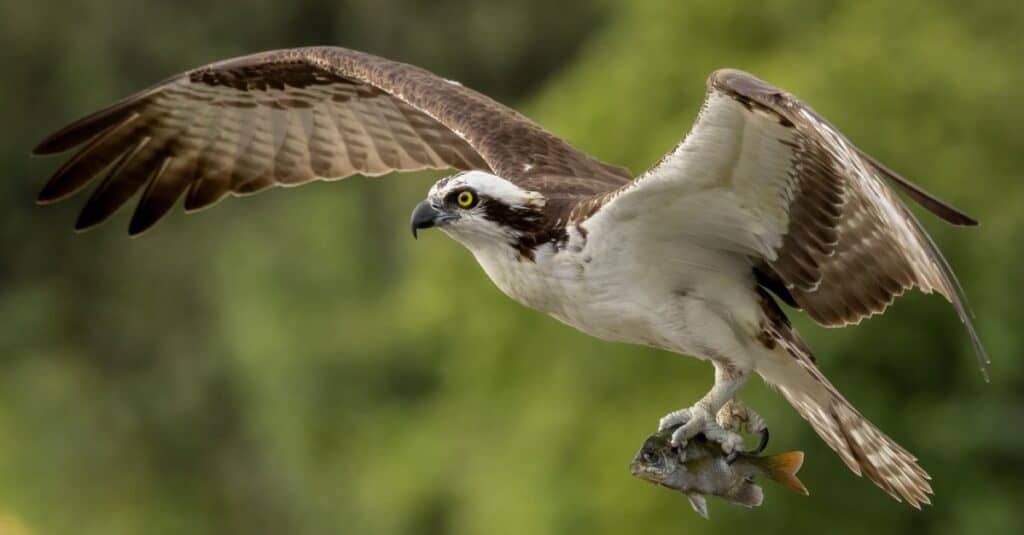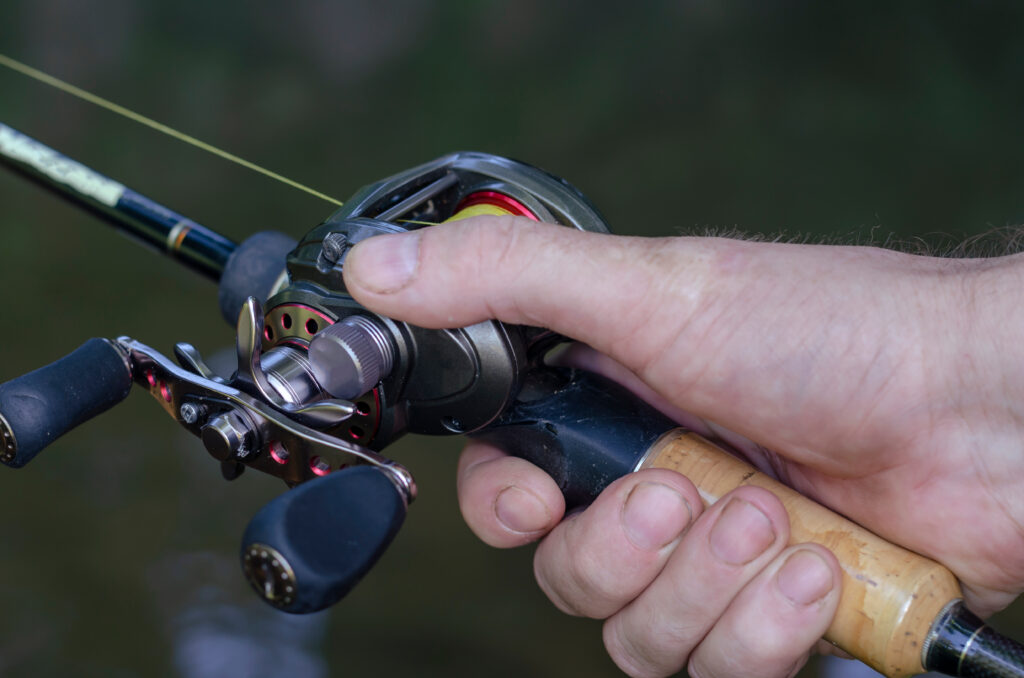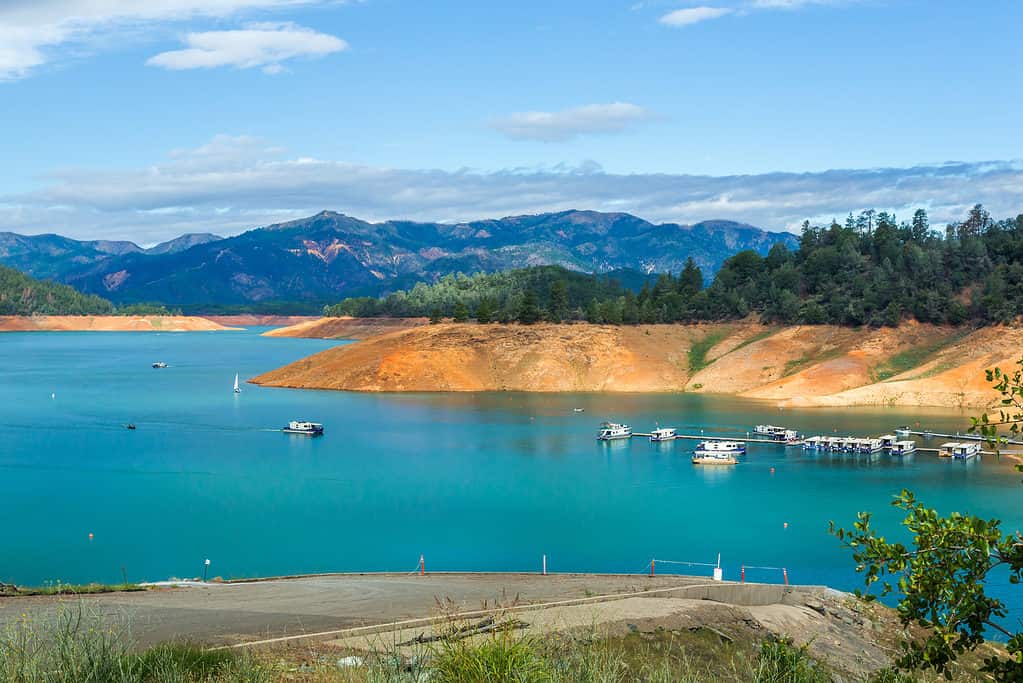
California has numerous man-made lakes, each with its unique history, features, and significance. These lakes are a testament to humans’ ingenuity, resourcefulness, and impact on the natural world.
From providing important water sources for agriculture and drinking water to serving as recreational destinations, man-made lakes play a vital role in California‘s landscape and economy.
Today, we discover the oldest man-made lake in California. We also provide an overview of its history, features, and environmental impact.
The Oldest Man-Made Lake in California

San Francisco is home to the oldest man-made lake in California.
©Kit Leong/Shutterstock.com
Lake Merced is the oldest man-made lake in California.
The lake is a hidden gem in the heart of San Francisco. Tucked away in the city’s southwestern corner, this lake is a favorite spot for locals looking to escape the hustle and bustle of urban life.
With its serene waters, lush vegetation, and diverse wildlife, Lake Merced offers a unique glimpse into the San Francisco Bay Area’s natural beauty.

Lake Merced is 50 feet deep in some areas.
Image: st4096ripe, Shutterstock
©st4096ripe/Shutterstock.com
History of Lake Merced
Lake Merced has a rich history that dates back thousands of years. Let’s explore the geological and human history of the lake.
Geological History
The San Francisco Bay Area and Lake Merced began to form millions of years ago as tectonic plates shifted, creating mountains, valleys, and a deep bay.
Over time, sediments and rocks eroded from the surrounding hills and were deposited in the Lake Merced basin.
Today, the lake is about 1.5 mi. long and 0.5 mi. wide, with a maximum depth of 50 ft. It’s fed by several small streams and drains into the Pacific Ocean through a channel at its western end.
Human History
The Ohlone people were the first human inhabitants of the area around Lake Merced. They played a crucial role in the lake’s creation.
The Ohlone people used the area for food, water, and spiritual purposes. They constructed a dam across one of the streams to create a larger body of water. This dam and other factors eventually led to the formation of Lake Merced as we know it today.
During California’s Spanish colonization, Spain and later Mexico claimed the area around Lake Merced.
The lake was named after the Merced de la Laguna Rancho, a large land grant encompassing much of the surrounding area.
The lake was used by ranchers for grazing and later by developers for industry and housing.
Uses of the Lake
Over time, the uses of Lake Merced have varied considerably. In the early 20th century, the lake was a popular recreation spot for:
- Swimming
- Boating
- Fishing
Lake Merced Boulevard’s construction in the 1930s significantly impacted the lake. It divided it into two separate water bodies and altered the water flow in and out of the lake.
In recent years, the lake has been designated as a conservation area. Consequently, efforts have been made to preserve and protect its natural beauty and wildlife. Today, visitors can enjoy the following activities in and around the lake:
- Hiking
- Bird-watching
- Other outdoor activities
Where Is Lake Merced Located on a Map?
Lake Merced is found on the west side of San Francisco in the Parkmerced neighborhood. Thornton State Beach, the San Francisco Zoo, and San Francisco State University are all located nearby.
Fauna in and Around Lake Merced

Ospreys, egrets, and great blue herons are a few of the birds that make their home at Lake Merced.
©iStock.com/Harry Collins
Lake Merced is home to diverse wildlife, including many bird species, fish, and mammals. Let’s explore the key fauna found in and around the lake.
Birds
Birdwatchers flock to Lake Merced to watch various bird species like:
The lake is also home to various waterfowl, such as:
- Mallards
- Coots
- Canvasbacks
These birds can be seen throughout the year but are most commonly observed during winter.
Fish
Several fish species can be found in Lake Merced, including:
Anglers can fish for these species from the shore or a boat. In addition, the lake is stocked with trout during winter, making it a popular spot for trout fishing.
Mammals
Several mammal species can be found in and around Lake Merced, including:
The lake also has various rodents, such as squirrels and mice.
Coyotes have been spotted in the area. As a visitor, keep a safe distance if they encounter one.
Flora in and Around Lake Merced
The ecosystem around Lake Merced is also home to various plant species. They provide essential habitat and food sources for the wildlife in the area.
Let’s explore key flora in and around the lake, including their habitats and ecological significance.
Trees
The area around Lake Merced is dominated by several species of trees like:
- Eucalyptus
- Coast live oak
- California bay laurel
These trees provide important habitats for birds and other wildlife. Moreover, their leaves and fruits are an important food source for many species.
Shrubs
Several species of shrubs can also be found in the area around Lake Merced, including:
- Toyon
- Coyote brush
- Coffeeberry
These plants provide important cover and nesting habitats for birds and small mammals. Additionally, their berries and seeds are an important food source.
Grasses and Wildflowers
The grassy areas around Lake Merced are home to several species of grasses and wildflowers, including:
- California poppies
- Lupines
- Wild oats
These plants provide important habitats for insects and small mammals. Besides, their seeds and nectar are an important food source for many species of birds and insects.
Restoration Efforts
Efforts have been made to restore and preserve the native plant species around Lake Merced. But unfortunately, many activities and non-native invasive species have impacted many of these plants.
The San Francisco Recreation & Parks Department (SFRP) has implemented measures to control non-native plants and restore the natural vegetation in the area. This has helped ensure the long-term ecological health of the lake and its surroundings.
Recreation and Activities

Fishing is one of the popular activities at the lake.
©Dmitriev Mikhail/Shutterstock.com
Lake Merced is a popular destination for outdoor enthusiasts and offers visitors various recreational activities. Let’s explore key activities and facilities available at the lake, including their accessibility and rules.
Boating and Fishing
Lake Merced is popular for boating and fishing. Visitors can rent boats or bring their own to enjoy the scenic views and water activities.
Fishing is allowed in designated areas and with a valid California fishing license.
Hiking and Biking
Several trails surround Lake Merced, providing a scenic backdrop for hiking and biking. These trails are accessible to visitors of all skill levels. In addition, they offer stunning views of the lake and surrounding landscape.
Picnicking and Barbecuing
Lake Merced features several picnic areas and barbecue pits, making it a great spot for a family outing or group gathering. Visitors are advised to reserve picnic areas in advance and follow all park rules and regulations.
Golfing
The Lake Merced Golf Club is a private club located near the lake and offers several challenging courses for golf enthusiasts. Visitors can also enjoy the scenic views and landscapes around the golf course.
Rules and Regulations
Visitors to Lake Merced are advised to follow all park rules and regulations, including guidelines on the following:
- Fishing
- Boating
- Picnicking
Be sure to always keep pets on a leash. Don’t feed the wildlife or disturb their natural habitat.
Environmental Challenges and Conservation Efforts
While Lake Merced is a beautiful and precious natural resource, it has its environmental challenges. Let’s explore the lake’s challenges and the conservation efforts underway to protect and preserve this important ecosystem.
Non-Native Species
Like many natural areas in California, Lake Merced has been impacted by non-native species introduced to the area through human activity.
These non-native species can displace native plants and wildlife and upset the ecosystem’s natural balance. Therefore, the SFRP has implemented measures to control and remove non-native species and restore native habitats.
Water Quality
Lake Merced’s water quality has been a topic of concern for many years due to various factors, including:
- Pollution from urban runoff
- Sewage overflow
- Historic industrial use
The San Francisco Public Utilities Commission has implemented measures to monitor and improve water quality in the lake and surrounding watershed.
Climate Change
Climate change is a global challenge impacting ecosystems worldwide, including Lake Merced.
The changing climate can impact:
- Water levels
- Temperature
- Weather patterns
All these can significantly impact the plants and animals that call the lake home.
Conservation Efforts
Despite Lake Merced’s challenges, many conservation efforts are underway to protect and preserve this important ecosystem. The SFRP, in partnership with other organizations and volunteers, has implemented measures to:
- Restore native habitats
- Control non-native species
- Monitor water quality
These efforts are helping to ensure that Lake Merced remains a beautiful and healthy natural resource for generations to come.
Other Man-Made Lakes in California

Lake Shasta is the largest artificial reservoir in California.
©iStock.com/Strekoza2
Aside from Lake Merced, California has many other significant man-made lakes, each with its unique history and features. Here are other man-made lakes in California:
Lake Berryessa
Lake Berryessa is located in Napa County, California. It was created in the mid-20th century when the Monticello Dam was constructed to provide irrigation water for nearby agricultural lands.
The lake is also an important source of drinking water for several regional cities. In addition, Lake Berryessa is a popular destination for fishing, boating, and camping. It’s also an important habitat for various fish and wildlife species.
Lake Shasta
Lake Shasta is California’s largest man-made reservoir. Its creation resulted from the Shasta Dam’s construction on the Sacramento River.
The lake provides important water storage and hydroelectric power for the region. It’s also a popular destination for boating, fishing, and camping.
Lake Oroville
Lake Oroville, located in Northern California, was created by Oroville Dam’s construction on the Feather River.
The lake provides important water storage for agriculture, hydroelectric power generation, and recreational opportunities like boating and fishing.
San Luis Reservoir
San Luis Reservoir, located in Central California, was created by the San Luis Dam’s construction on the San Joaquin River. The reservoir is a crucial source of irrigation water for the region’s agriculture. Besides, it provides opportunities for boating, fishing, and hiking.
Don Pedro Reservoir
Don Pedro Reservoir, located in the Sierra Nevada foothills, was created by the Don Pedro Dam’s construction on the Tuolumne River.
The reservoir provides important water storage for agriculture and hydroelectric power. It’s also popular for boating, fishing, and camping.
Lake Cuyamaca
Lake Cuyamaca is located in San Diego County. It’s a small man-made lake created in the 19th century to provide water for the surrounding community.
Today, the lake is a popular destination for:
- Boating
- Fishing
- Camping
- Hiking
- Wildlife viewing
Castaic Lake
Castaic Lake, located in Los Angeles County, is a man-made lake created in the 1970s as part of the Castaic Dam project.
The lake is popular for boating, fishing, and camping. It’s also a crucial habitat for various fish and wildlife species.
Lake Perris
Lake Perris, located in Riverside County, is a man-made lake created in the 1970s as part of the Perris Dam project.
The lake is a popular destination for:
- Boating
- Fishing
- Camping
It’s also a crucial habitat for various fish and wildlife species.
Key Takeaways
Lake Merced is a gem nestled in the heart of San Francisco that has captivated visitors for generations. Lake Merced has something for everyone, from its rich history to its diverse flora and fauna and the many recreational opportunities it offers.
But as we have seen, this precious resource has its challenges. Non-native species, water quality, and climate change are all issues that require ongoing attention and conservation efforts. This will ensure Lake Merced remains a healthy and thriving ecosystem for generations to come.
The photo featured at the top of this post is © Kit Leong/Shutterstock.com
Thank you for reading! Have some feedback for us? Contact the AZ Animals editorial team.






